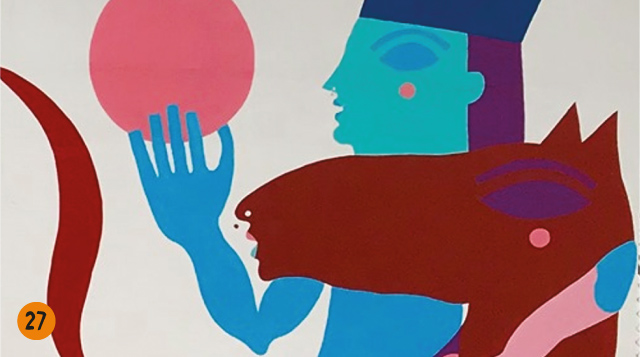Notturna

Obra – PT
27 – Título: NOTTURNA
Num determinado ponto na história, a sociedade acreditava que as mulheres conseguiam voar e que se reuniam durante a noite, partindo de todo o mundo, para dançar e ter sexo com o diabo debaixo da grande nogueira de Benevento. Como oferendas levavam bebés raptados para os sacrificar nas noites de lua vermelha.
Também havia lendas dobre homens a voar, mas essas nunca suscitaram grande interesse.
A invenção do Diabo e todas essas histórias em seu torno, hoje em dia quase ridículas, foram uma das principais razões que levaram ao genocídio, e não apenas de mulheres, por parte da Inquisição Espanhola entre 1300 e 1700.
“Notturna” retrata uma comunidade de mulheres a trabalhar em conjunto para organizar um festival de Primavera, onde homens e mulheres (ou apenas mulheres) poderiam dançar, beber e fazer sexo todos juntos para fertilizar a terra. Em determinado ponto da história, as mulheres eram consideradas seres noturnos, escondidos e dedicadas a organizar encontros luxuriosos com seres misteriosos. Estes rituais pagãos e festivais eram utilizados para difamar as bruxas e foram a origem do estigma contra elas.
Obra – ENG
27 – Title: NOTTURNA
At some point in history, society started believing that women could fly and would gather at night, leaving from all over the world, to dance naked and have sex with the Devil under the big walnut tree of Benevento. They would bring as gifts kidnapped babies to sacrifice them on the nights of the red moon.
I’ve learned that there are popular tales of men seen flying too but they never bothered much.
The invention of the Devil and all these anecdotes that nowadays sound quite amusing, were the main reasons which led to the genocide, and not just of women, by the Spanish Inquisition between the years 1300 and 1700.
Notturna portrays a community of women working together to organise a Spring party where men and women (or just women) would dance, drink and have sex together to fertilise the soil.
At some point in history, women were considered to be nocturnal creatures, hidden, lowly beings, dedicated to organising lustful encounters with mysterious beings.
These Pagan rituals and feasts were used to defame the witches and Sabbaths and were the beginning of the stigma against them.
Gio Pistone
Bio – PT
Nasceu em Roma e começou a pintar murais desde muito cedo, começando nas paredes do seu quarto e nas do escritório da sua mãe. Normalmente, os temas eram relacionados com criaturas fantásticas e monstros, retratados com cores fortes, tal como lhe apareciam nos seus pesadelos. Começou a pintá-los de manhã, por sugestão da mãe, estudante de psicologia na altura.
Trabalhou como cenógrafa no teatro, permitindo-lhe continuar a sua paixão por obras de grande dimensão. Trabalhou e viajou com um grupo de designers crativos de jogos, que desenvolveram vários jogos e labirintos. Começou o seu trabalho na rua em 98, colando posters nas ruas de Roma. Trabalhou para muitos jornais e revistas em Itália e pela Europa.
Participou em diversas exposições pela Europa, em particular em Berlim na galeria de arte Cell63, no Museu MADRE em Nápoles, no Auditorium em Roma. Participou ainda em vários eventos de street art como Scala Mercalli, Pop-Up, Subsidenze, Visione Periferica e Alterazioni.
Trabalhou também no Street Art Museum de São Petersburgo.
Bio – ENG
Born in Rome, Gio Pistone threw herself in painting murals at a young age, from the walls of her room to those of her mother’s office. Her subjects of choice, typically fantastical creatures bordering on monsters, are characterized by strong colors that also presented themselves in her nightmares. Drawing them the morning after was the idea of her mother, then a psychology student, and soon the nightmares during into the visions that she continues to draw
She worked as a set designer in theater, where she continued to research her dreams and her love for large-scale work. Following this experience, she worked and traveled with “La syndrome del topo,” a group of creative game designers, who conceived and designed games and labyrinths. She began working in the street in ’98, pasting posters of her photocopied posters on the streets of Rome.
She has collaborated with you have worked for many newspapers and magazines in Italy and Europe
Gio has participated in exhibitions throughout Europe, in particular in Berlin at Cell63 artgallery, at the MADRE Museum in Naples, the Auditorium in Rome, and has participated in street art events such as Scala Mercalli, Pop-Up, Subsidenze, Visione Periferica, Alterazioni, she has worked in Street Art Museum St. Petersburg.
